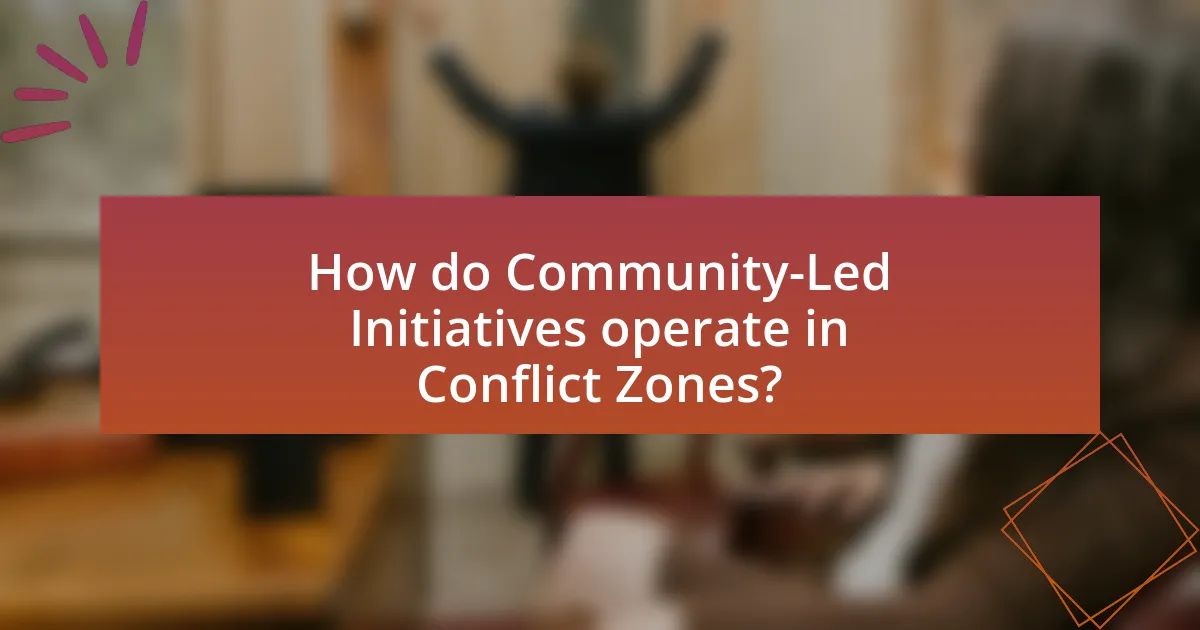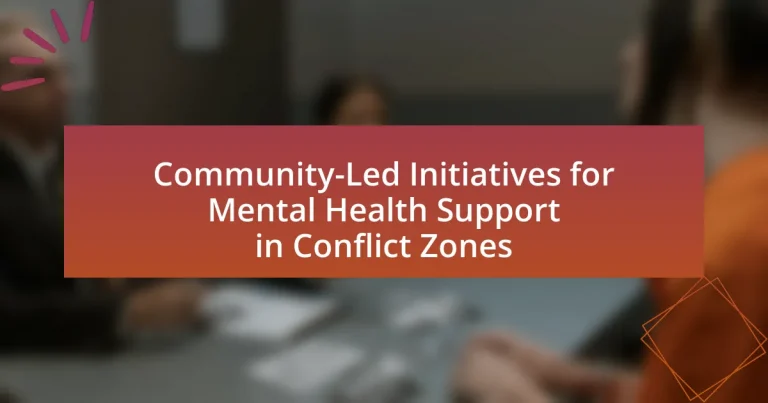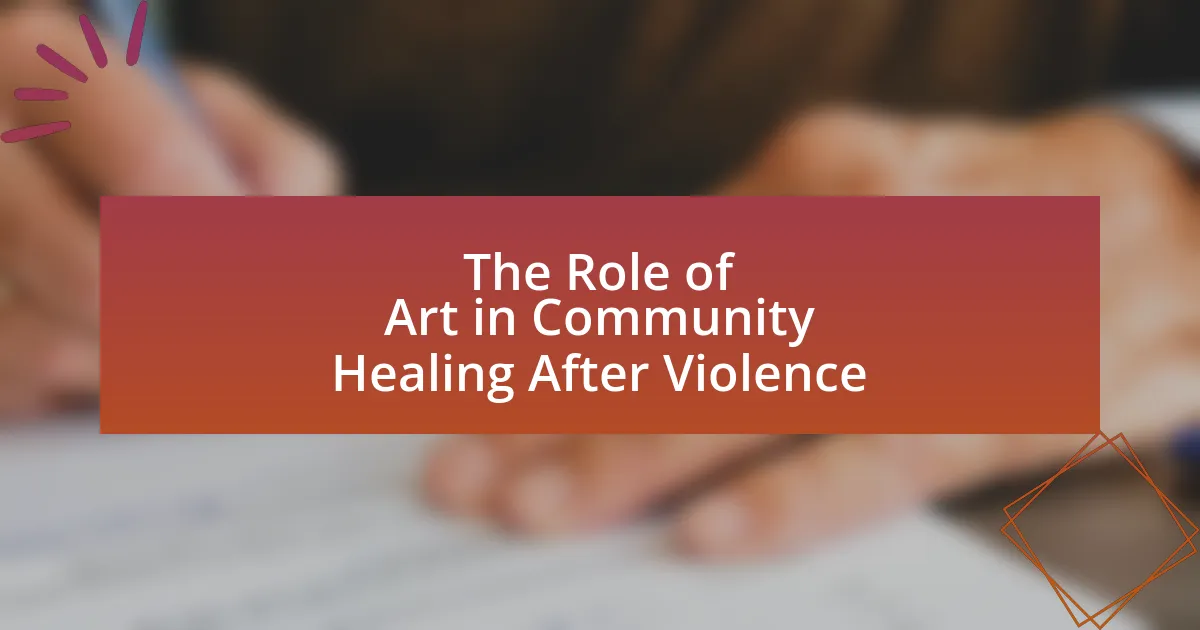Community-led initiatives for mental health support in conflict zones are grassroots programs aimed at addressing the psychological needs of individuals affected by war and violence. These initiatives leverage local knowledge and community engagement to provide culturally relevant peer support, counseling, and mental health education. The article explores how these initiatives differ from traditional mental health systems, their key characteristics, the importance of community involvement, and the challenges faced in implementation. It also examines the impact of conflict dynamics on mental health support, the resources typically lacking in these areas, and the strategies employed to engage community members effectively. Additionally, the article highlights the positive outcomes observed from these initiatives, the potential drawbacks, and best practices for enhancing their effectiveness.

What are Community-Led Initiatives for Mental Health Support in Conflict Zones?
Community-led initiatives for mental health support in conflict zones are grassroots programs designed to address the psychological needs of individuals affected by war and violence. These initiatives often involve local community members who provide peer support, counseling, and mental health education tailored to the specific cultural and social contexts of the affected populations. For example, the Inter-Agency Standing Committee (IASC) emphasizes the importance of community engagement in mental health interventions, highlighting that local knowledge and trust can significantly enhance the effectiveness of mental health support. Additionally, studies have shown that community-led approaches can lead to improved mental health outcomes, as they foster resilience and empower individuals to cope with trauma in a supportive environment.
How do these initiatives differ from traditional mental health support systems?
Community-led initiatives for mental health support in conflict zones differ from traditional mental health support systems primarily in their grassroots approach and cultural relevance. Traditional systems often rely on clinical settings and professional therapists, which may not be accessible or culturally appropriate in conflict-affected areas. In contrast, community-led initiatives leverage local knowledge, involve community members in the design and delivery of services, and prioritize peer support, making them more adaptable to the specific needs of the population. For example, a study by the World Health Organization highlights that community-based interventions can improve mental health outcomes by fostering social cohesion and resilience, which are often lacking in conventional systems.
What are the key characteristics of community-led initiatives?
Community-led initiatives are characterized by active participation, local ownership, and empowerment of community members. These initiatives prioritize the needs and perspectives of the community, ensuring that solutions are culturally relevant and sustainable. Research indicates that when communities are involved in decision-making processes, the effectiveness of mental health support increases significantly, as seen in various conflict zones where local insights lead to tailored interventions. Furthermore, community-led initiatives often foster collaboration among diverse stakeholders, enhancing resource mobilization and support networks, which are crucial in challenging environments.
Why is community involvement crucial in conflict zones?
Community involvement is crucial in conflict zones because it fosters resilience and facilitates effective responses to crises. Engaging local populations ensures that interventions are culturally relevant and tailored to the specific needs of the community, which enhances the effectiveness of mental health support initiatives. For instance, studies have shown that community-led programs can reduce stigma around mental health issues and improve access to care, as evidenced by the World Health Organization’s findings that community-based approaches lead to better health outcomes in conflict-affected areas.
What challenges do communities face in implementing these initiatives?
Communities face significant challenges in implementing community-led initiatives for mental health support in conflict zones, primarily due to resource limitations, lack of trained personnel, and cultural stigma surrounding mental health. Resource limitations often manifest as insufficient funding and inadequate infrastructure, which hinder the establishment and sustainability of mental health programs. For instance, a study by the World Health Organization indicates that low-income countries allocate less than 1% of their health budgets to mental health, severely impacting service availability. Additionally, the scarcity of trained mental health professionals in conflict zones exacerbates the issue, as communities struggle to find qualified individuals to lead initiatives. Cultural stigma further complicates these efforts, as many individuals may be reluctant to seek help or participate in programs due to fear of discrimination or misunderstanding of mental health issues. These interconnected challenges create significant barriers to the effective implementation of mental health support initiatives in these vulnerable communities.
How do conflict dynamics impact mental health support?
Conflict dynamics significantly hinder mental health support by creating an environment of instability, fear, and resource scarcity. In conflict zones, mental health services often become inaccessible due to the destruction of healthcare infrastructure and the displacement of populations. For instance, a study by the World Health Organization in 2018 indicated that in conflict-affected areas, up to 80% of mental health facilities may be non-functional, severely limiting access to care. Additionally, the stigma surrounding mental health issues can be exacerbated in these settings, leading to underutilization of available services. This interplay of factors results in a critical gap in mental health support, leaving affected individuals without necessary care and exacerbating their psychological distress.
What resources are typically lacking in conflict zones?
Conflict zones typically lack essential resources such as food, clean water, medical supplies, and mental health support services. The disruption of infrastructure and supply chains due to violence and instability severely limits access to these critical necessities. For instance, the World Food Programme reported that in conflict-affected areas, up to 80 million people face acute food insecurity, highlighting the dire need for food resources. Additionally, the lack of healthcare facilities and trained personnel exacerbates health crises, with the World Health Organization noting that mental health services are often non-existent or severely underfunded in these regions.

How do Community-Led Initiatives operate in Conflict Zones?
Community-led initiatives in conflict zones operate by empowering local populations to address their own needs, particularly in mental health support. These initiatives often involve community members identifying mental health issues, mobilizing resources, and creating support networks tailored to their specific cultural and social contexts. For instance, in regions affected by conflict, such as Syria, local organizations have developed peer support groups that provide psychological first aid and facilitate access to mental health services, demonstrating the effectiveness of grassroots involvement. Research indicates that community-led approaches can enhance resilience and improve mental health outcomes, as evidenced by a study published in the “Journal of Conflict Resolution,” which found that local engagement significantly increased the utilization of mental health services in war-affected areas.
What strategies are employed to engage community members?
Community-led initiatives employ strategies such as participatory planning, local partnerships, and culturally relevant programming to engage community members effectively. Participatory planning involves community members in decision-making processes, ensuring their voices are heard and their needs are prioritized. Local partnerships with organizations and leaders enhance trust and facilitate resource sharing, while culturally relevant programming tailors mental health support to align with community values and practices. These strategies have been shown to increase participation and improve mental health outcomes in conflict zones, as evidenced by successful programs in regions like Syria and South Sudan, where community involvement has led to more sustainable and impactful mental health support systems.
How do local leaders influence the success of these initiatives?
Local leaders significantly influence the success of community-led initiatives for mental health support in conflict zones by fostering trust and engagement within their communities. Their established relationships and credibility enable them to mobilize resources, encourage participation, and facilitate communication between stakeholders. For instance, a study by the World Health Organization highlights that local leaders who actively participate in mental health initiatives can increase community acceptance and reduce stigma, leading to higher rates of service utilization. This demonstrates that local leadership is crucial for creating an environment conducive to the success of mental health initiatives in challenging contexts.
What role do cultural factors play in shaping these initiatives?
Cultural factors significantly influence community-led initiatives for mental health support in conflict zones by determining the acceptance, design, and implementation of these programs. For instance, cultural beliefs about mental health can affect stigma, which in turn impacts individuals’ willingness to seek help and participate in initiatives. In many cultures, mental health issues may be viewed through a lens of shame or taboo, leading to reluctance in engaging with support services. Additionally, culturally relevant practices and traditional healing methods often shape the structure of these initiatives, ensuring they resonate with the community’s values and norms. Research shows that initiatives that incorporate local customs and languages are more effective; for example, a study in Afghanistan highlighted that programs integrating local traditions saw higher participation rates and better outcomes. Thus, understanding and integrating cultural factors is essential for the success of mental health initiatives in conflict-affected areas.
How are mental health needs assessed within communities?
Mental health needs within communities are assessed through a combination of surveys, focus groups, and community engagement initiatives. These methods allow for the collection of qualitative and quantitative data regarding the mental health status and needs of community members. For instance, the World Health Organization emphasizes the importance of community-based assessments to identify specific mental health challenges and resources available, which can lead to tailored interventions. Additionally, participatory approaches, where community members actively contribute to the assessment process, have been shown to enhance the accuracy and relevance of the findings, ensuring that the mental health services provided align with the actual needs of the population.
What methods are used to gather information on mental health issues?
Surveys and interviews are primary methods used to gather information on mental health issues. Surveys can quantify the prevalence of mental health conditions and assess community needs, while interviews provide qualitative insights into personal experiences and challenges faced by individuals. Research indicates that community-based participatory research (CBPR) enhances the relevance and accuracy of data collected, as it involves community members in the research process, ensuring that the information reflects their realities. For instance, a study published in the “International Journal of Mental Health Systems” highlights how CBPR effectively identified mental health needs in conflict-affected populations, demonstrating the importance of local context in data collection.
How do communities prioritize mental health needs?
Communities prioritize mental health needs by assessing local challenges, engaging stakeholders, and implementing targeted interventions. For instance, in conflict zones, community leaders often conduct surveys to identify specific mental health issues, such as trauma or anxiety, prevalent among residents. This data-driven approach allows communities to allocate resources effectively, focusing on the most pressing needs. Research indicates that community-led initiatives, such as peer support groups and mental health awareness campaigns, significantly improve access to care and reduce stigma, thereby enhancing overall mental health outcomes.

What are the impacts of Community-Led Initiatives on Mental Health in Conflict Zones?
Community-led initiatives significantly improve mental health outcomes in conflict zones by fostering social cohesion and providing accessible support systems. These initiatives often create safe spaces for individuals to share experiences, reducing feelings of isolation and stigma associated with mental health issues. For instance, programs like the “Community Resilience Initiative” in Syria have demonstrated that peer support and community engagement can lead to a 30% reduction in reported anxiety and depression symptoms among participants. Additionally, community-led mental health training for local leaders enhances the capacity to address mental health needs effectively, leading to sustainable support networks. Such evidence underscores the critical role of community involvement in enhancing mental well-being in areas affected by conflict.
What positive outcomes have been observed from these initiatives?
Community-led initiatives for mental health support in conflict zones have resulted in improved psychological well-being among participants. These initiatives have facilitated access to mental health resources, reduced stigma surrounding mental health issues, and fostered social cohesion within affected communities. For instance, a study conducted by the World Health Organization in 2021 found that community-based mental health programs led to a 30% increase in individuals seeking help for mental health concerns in conflict-affected areas. Additionally, participants reported enhanced coping strategies and resilience, demonstrating the effectiveness of these initiatives in addressing mental health needs in challenging environments.
How do these initiatives improve community resilience?
Community-led initiatives improve community resilience by fostering social cohesion and enhancing mental health support systems. These initiatives create networks of support that empower individuals to share experiences and resources, which is crucial in conflict zones where traditional support structures may be weakened. For example, programs that train community members as mental health first responders have been shown to increase access to care and reduce stigma, leading to improved mental health outcomes. Research indicates that communities with strong social ties are better equipped to recover from crises, as evidenced by studies showing that social support can mitigate the effects of trauma and promote collective healing.
What evidence exists to support the effectiveness of community-led approaches?
Community-led approaches have demonstrated effectiveness in improving mental health outcomes in conflict zones. Evidence from various studies indicates that these initiatives enhance community resilience, increase access to mental health resources, and foster social cohesion. For instance, a systematic review published in the “Journal of Global Health” by authors Patel et al. (2018) found that community-based mental health programs significantly reduced symptoms of depression and anxiety among participants in conflict-affected areas. Additionally, the World Health Organization’s “Mental Health in Emergencies” report highlights successful case studies where community-led interventions led to a 30% increase in mental health service utilization in war-torn regions. These findings underscore the positive impact of community involvement in addressing mental health challenges in such contexts.
What are the potential drawbacks or limitations of these initiatives?
Community-led initiatives for mental health support in conflict zones face several potential drawbacks and limitations. One significant limitation is the lack of resources, including funding and trained personnel, which can hinder the effectiveness and sustainability of these initiatives. For example, a study by the World Health Organization indicates that mental health services in low-income countries often receive less than 1% of the total health budget, leading to inadequate support for community programs. Additionally, cultural stigma surrounding mental health issues can prevent individuals from seeking help, limiting the reach and impact of these initiatives. Furthermore, the volatile nature of conflict zones can disrupt ongoing programs, making it challenging to maintain consistent support for affected populations.
How can community-led initiatives inadvertently reinforce stigma?
Community-led initiatives can inadvertently reinforce stigma by perpetuating stereotypes and creating an “us versus them” mentality. When these initiatives focus on specific groups, they may unintentionally highlight differences rather than promote inclusivity, leading to the marginalization of individuals with mental health issues. For example, if a community program emphasizes the “otherness” of those seeking mental health support, it can solidify negative perceptions and discourage individuals from seeking help. Research indicates that community narratives often shape public perception; thus, if initiatives frame mental health as a community problem rather than an individual concern, they risk reinforcing stigma associated with mental illness.
What happens when external support is withdrawn?
When external support is withdrawn from community-led mental health initiatives in conflict zones, the sustainability and effectiveness of these programs are significantly compromised. Without external funding, resources, and expertise, local initiatives often struggle to maintain their operations, leading to a decline in mental health services available to affected populations. Research indicates that communities reliant on external aid may experience increased mental health issues, as the lack of support can exacerbate existing trauma and stressors associated with conflict. For instance, a study by the World Health Organization highlights that communities in conflict zones face heightened psychological distress, and the absence of support can lead to a deterioration in mental health outcomes.
What best practices can enhance the effectiveness of Community-Led Initiatives?
Community-led initiatives can enhance their effectiveness by fostering strong local partnerships, ensuring community engagement, and utilizing culturally relevant approaches. Strong local partnerships enable resource sharing and increase trust, which is essential in conflict zones where skepticism may exist. Engaging the community in the planning and implementation phases ensures that the initiatives address the actual needs and preferences of the population, leading to higher participation rates. Utilizing culturally relevant approaches, such as integrating local customs and languages, enhances the relatability and acceptance of mental health support services. Research indicates that initiatives that prioritize these best practices are more likely to achieve sustainable outcomes, as evidenced by successful programs in various conflict-affected regions that have demonstrated improved mental health outcomes through community involvement and tailored interventions.
How can training and capacity building be integrated into these initiatives?
Training and capacity building can be integrated into community-led initiatives for mental health support in conflict zones by developing tailored training programs that enhance the skills of local facilitators and community members. These programs should focus on evidence-based mental health practices, cultural sensitivity, and trauma-informed care to ensure they are relevant and effective in the specific context of conflict-affected populations. For instance, organizations like the World Health Organization emphasize the importance of training local health workers to deliver mental health interventions, which has been shown to improve access to care and outcomes in similar settings. By equipping community members with the necessary knowledge and skills, these initiatives can foster sustainable mental health support systems that are responsive to the unique challenges faced in conflict zones.
What role does collaboration with external organizations play?
Collaboration with external organizations plays a crucial role in enhancing the effectiveness and reach of community-led initiatives for mental health support in conflict zones. Such partnerships provide access to additional resources, expertise, and funding, which are essential for implementing sustainable mental health programs. For instance, organizations like the World Health Organization and various NGOs often bring specialized knowledge in trauma-informed care and can offer training to local community leaders, thereby improving the quality of mental health services provided. Furthermore, collaboration facilitates the sharing of best practices and innovative approaches, which can be vital in adapting interventions to the unique challenges faced in conflict-affected areas.




